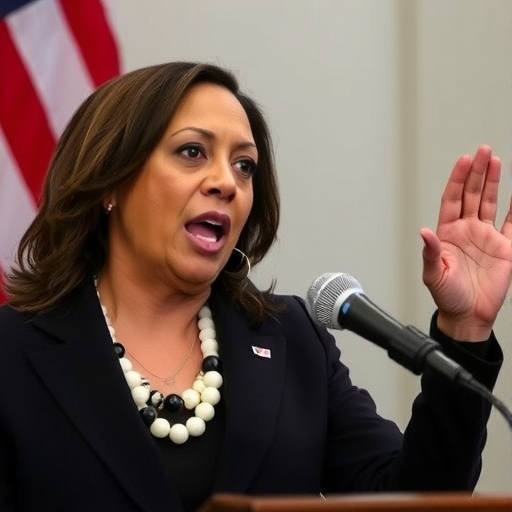Kamala Harris Eyes 2028 Presidential Run: Democratic Party Grapples with Leadership Shake-Up After 2024 Loss
In a move that’s sending ripples through the corridors of US politics, former Vice President Kamala Harris has subtly signaled her interest in pursuing the presidency once more in the 2028 election. This revelation, dropped during a recent interview on a popular podcast, comes just months after her narrow defeat in the 2024 presidential race against incumbent President Donald Trump. Harris’s words have reignited fierce debates within the Democratic Party about who should lead the party forward, her electability, and the strategic pivots needed to reclaim the White House.
The podcast appearance, hosted by a prominent progressive voice, saw Harris reflect on her tenure and future ambitions with uncharacteristic candor. “I’ve always believed in fighting for the soul of this nation, and that fight doesn’t end with one election,” she stated, her tone laced with determination. This isn’t mere rhetoric; insiders whisper that Harris has already begun assembling a shadow campaign team, drawing from her 2020 and 2024 war chests. With the Democratic National Committee still reeling from the 2024 setback—where they lost not only the presidency but also slim majorities in Congress—the party’s future hangs in the balance.
Harris’s potential bid isn’t without controversy. Polls from early 2025 show her favorability hovering around 45% among Democrats, a dip from her 2020 peak but still ahead of many rivals. The 2028 election landscape is wide open, with no clear frontrunner emerging from the ashes of 2024. Yet, her signal has forced party elders, rising stars, and grassroots activists to confront uncomfortable questions: Can Harris, often criticized for her prosecutorial past and uneven campaign trail presence, unify a fractured Democratic Party?
Harris’s Post-2024 Pivot: From Defeat to Determination
Following her 2024 loss, which analysts attribute to a mix of economic anxieties, border security concerns, and Trump’s enduring populist appeal, Kamala Harris retreated from the spotlight but not from the fight. In the ensuing months, she embarked on a listening tour across battleground states like Pennsylvania, Michigan, and Georgia—areas that flipped red in 2024. During these visits, Harris focused on issues close to her heart: voting rights, reproductive justice, and economic equity for working families.
One pivotal moment came in Atlanta last month, where Harris addressed a crowd of 5,000 at a voter mobilization rally. “We came so close in 2024 because the American people saw our vision,” she declared, her voice rising over cheers. “But closeness isn’t enough. We must build coalitions that last, strategies that win.” Sources close to Harris reveal that these appearances are no accident; they’re beta tests for her 2028 election messaging. Her team has reportedly raised over $10 million in small-dollar donations since January, signaling robust grassroots support.
Yet, the pivot isn’t seamless. Harris’s 2024 campaign faced scrutiny for its handling of inflation and immigration—issues where Trump hammered her relentlessly. A post-election autopsy by the Democratic Party highlighted internal divisions, with some blaming Harris’s debate performances for alienating moderates. Undeterred, Harris has hired veteran strategists like Stephanie Cutter, who orchestrated Obama’s 2012 reelection, to refine her approach. This recalibration aims to address electability concerns head-on, positioning her as a battle-tested leader ready for round two.
Statistics underscore the stakes. A January 2025 Gallup poll indicated that 52% of Democrats want a fresh face for 2028, but 38%—a plurality—still back Harris. Her tenure as Vice President, marked by historic firsts as the first woman, first Black, and first South Asian in the role, adds layers of symbolism. However, critics argue that symbolism alone won’t suffice against a potentially resurgent Republican machine.
Democratic Insiders Clash Over Harris’s Viability
The Democratic Party‘s reaction to Harris’s signals has been a whirlwind of endorsements, skepticism, and strategic maneuvering. High-profile figures like California Governor Gavin Newsom have praised her tenacity, tweeting, “Kamala Harris has the experience and fire to lead us back to victory in 2028.” Newsom, often seen as a potential rival, appears to be extending an olive branch, perhaps calculating that aligning early could bolster his own ambitions.
Contrast this with sharper critiques from the party’s left flank. Progressive Senator Bernie Sanders, in a recent op-ed for The Nation, urged the Democratic Party to “learn from 2024’s failures” and prioritize bold economic reforms over establishment figures like Harris. Sanders’s comments echo a broader tension: the divide between the party’s progressive wing, which views Harris as too centrist, and moderates who credit her with shoring up key demographics like Black voters, who turned out at 65% in 2024 despite the loss.
Party chair Jaime Harrison has called for unity, stating in a DNC memo leaked to Politico, “The 2028 election demands we rally around proven leaders who can expand our map.” But whispers of a contested primary abound. Potential challengers include Transportation Secretary Pete Buttigieg, whose Midwestern appeal could siphon white working-class votes, and Pennsylvania Governor Josh Shapiro, a rising star with crossover appeal. A March 2025 Emerson poll pits Harris against these names, showing her leading with 32% in a crowded field, but with 25% undecided—a volatile margin.
Behind the scenes, donor networks are mobilizing. Wall Street allies, who funneled $200 million to Harris’s 2024 PAC, remain loyal, while Silicon Valley tech moguls like Reid Hoffman have hosted private dinners to discuss her presidency prospects. Conversely, labor unions like the AFL-CIO are split, with some leaders pushing for a more populist candidate to counter Trump’s narrative on trade and jobs.
Electability Hurdles: Border, Economy, and Beyond
Harris’s path to the 2028 election is fraught with electability challenges that dominated her 2024 bid. The border crisis, which she was tasked with addressing as Vice President, remains a flashpoint. In 2024, Trump ads portrayed her as ineffective, contributing to her underperformance in swing states like Arizona and Nevada, where Latino turnout dipped by 8% compared to 2020.
To counter this, Harris has pivoted toward comprehensive immigration reform. In a February speech at the Mexican American Legal Defense Fund, she outlined a plan emphasizing pathways to citizenship alongside stricter enforcement, drawing applause from advocates. “We need smart borders, not walls of hate,” she said, aiming to reclaim the narrative. Polling from Pew Research shows 60% of Democrats support such balanced approaches, but independents remain wary, with only 42% viewing her favorably on immigration.
Economically, Harris faces an uphill battle. The 2024 election saw inflation peak at 9.1% in mid-2022 under the Biden-Harris administration, eroding trust among suburban voters. Recent data from the Bureau of Labor Statistics indicates cooling prices, with inflation at 2.5% by early 2025, but wage stagnation persists for many. Harris’s proposed “Opportunity Economy” agenda—focusing on child tax credits, affordable housing, and green jobs—seeks to address this. During a town hall in Detroit, she shared a personal story: “As a child of immigrants, I know the grind of making ends meet. That’s why we’ll fight for families like mine.”
Gender and racial dynamics add complexity. As the first female nominee, Harris shattered barriers but faced misogynistic attacks that some say suppressed women’s turnout. A 2025 study by the Center for American Women and Politics found that 15% of female voters cited discomfort with a female president as a factor in 2024. Harris’s team is countering with targeted outreach, including partnerships with groups like EMILYs List, which has pledged $50 million to support women candidates in 2028.
Globally, US politics watchers note Harris’s foreign policy chops. Her diplomatic trips to Ukraine and Taiwan during her vice presidency positioned her as a steady hand amid rising authoritarianism. Yet, isolationist sentiments in the Democratic Party could complicate her pitch.
Polling Trends and Voter Shifts Shaping 2028
Early indicators for the 2028 election paint a picture of a polarized electorate eager for change. A comprehensive Quinnipiac poll from April 2025 reveals Harris leading Republican hopefuls like Florida Governor Ron DeSantis by 4 points nationally, but trailing in key states. Among young voters under 30, her support surges to 55%, driven by her advocacy on climate and student debt relief—issues where 70% of Gen Z prioritizes action, per Harvard’s Institute of Politics.
The Black vote, a Democratic bedrock, showed cracks in 2024, with turnout at 62% versus 66% in 2020. Harris’s signals have sparked renewed engagement; the NAACP reports a 20% uptick in voter registration drives invoking her name. In urban centers like Philadelphia and Milwaukee, community leaders praise her prosecutorial record turned toward justice reform, citing her role in California’s truancy laws and federal marijuana pardons.
Suburban women, a demographic Harris won by 10 points in 2020 but only 3 in 2024, represent another battleground. Focus groups conducted by Lake Research Partners highlight abortion rights as a mobilizer, post-Roe v. Wade. Harris’s vow to codify Roe on day one resonates, with 68% of this group supporting her in hypothetical matchups.
Broader US politics trends favor incumbency challenges. With Trump’s approval dipping to 48% amid ongoing legal battles, Democrats sense opportunity. However, third-party threats like Robert F. Kennedy Jr.’s lingering influence could siphon 5-7% of votes, per FiveThirtyEight models.
Strategic Roadmaps: Alliances, Fundraising, and Primaries Ahead
Looking toward 2028, Harris’s team is mapping a meticulous path. Key alliances include bolstering ties with the Congressional Black Caucus, whose endorsement could lock in Southern primaries. Fundraising remains a strength; her super PAC, “Future Forward,” has amassed $150 million by Q1 2025, outpacing rivals.
The primary calendar, likely starting in Iowa and New Hampshire, will test her endurance. Early states favor retail politics, where Harris’s charisma shines in small settings. Yet, a multi-candidate field could fragment the Democratic Party, prolonging the race into Super Tuesday.
Forward implications are profound. A Harris-led resurgence could redefine US politics, emphasizing diversity and progressive policies. If she falters, it might usher in a new era of Democratic leadership, perhaps tilting left or center. As one anonymous DNC strategist put it, “Harris isn’t just running for president; she’s running to save the party’s soul.” The 2028 election looms as a referendum on resilience, with Harris at its epicenter.









